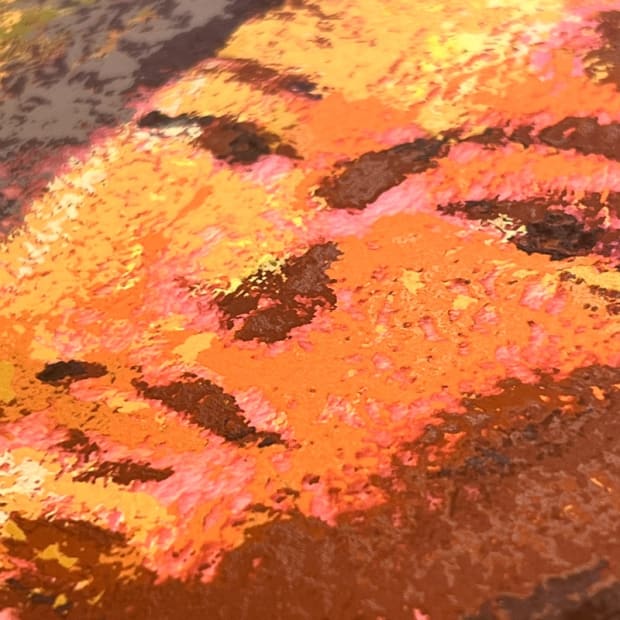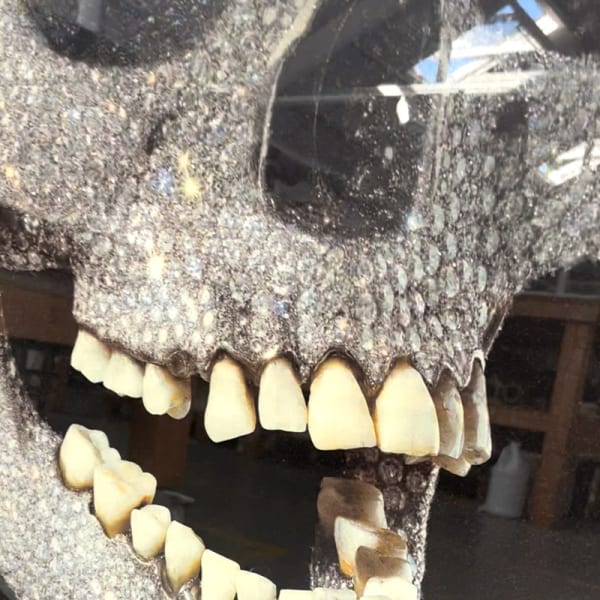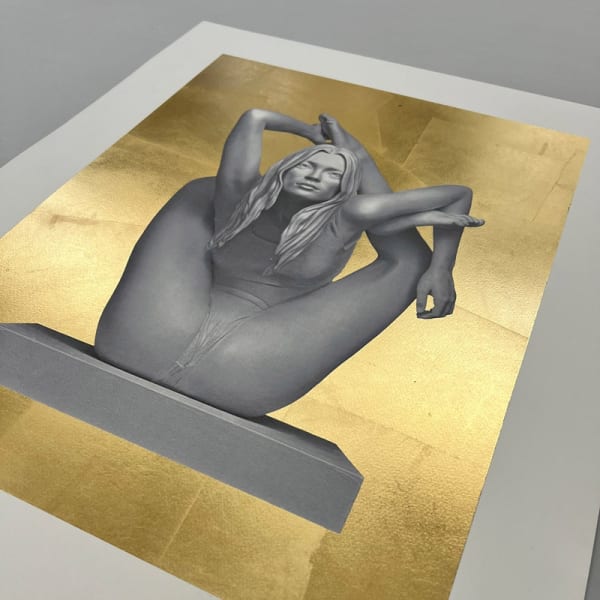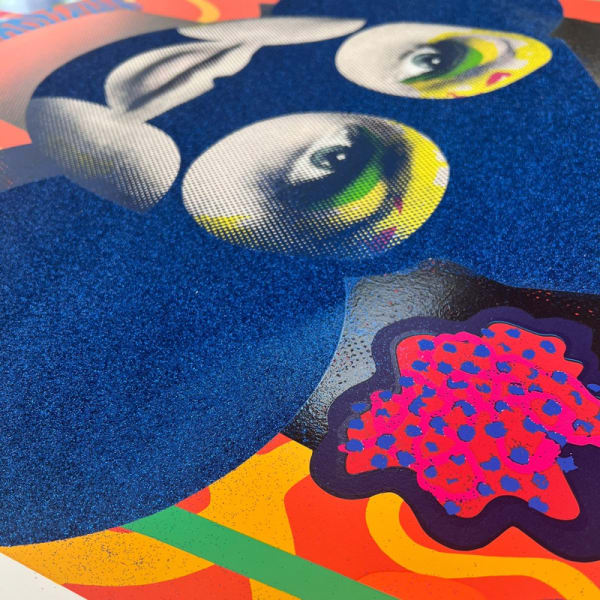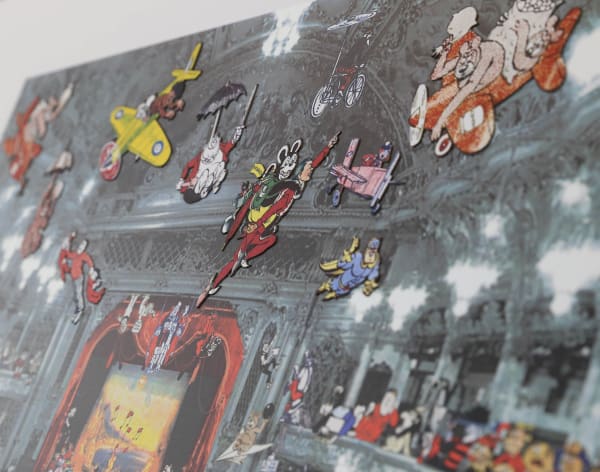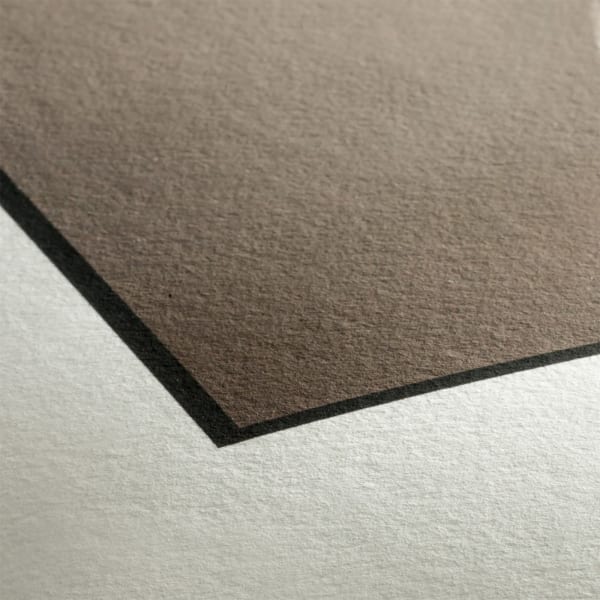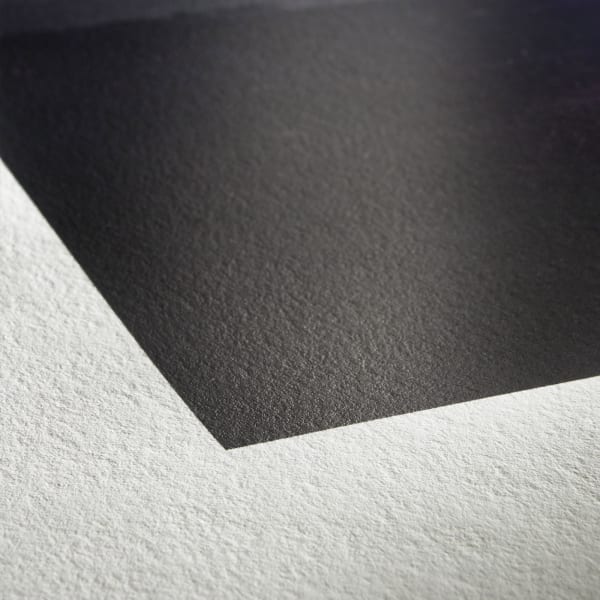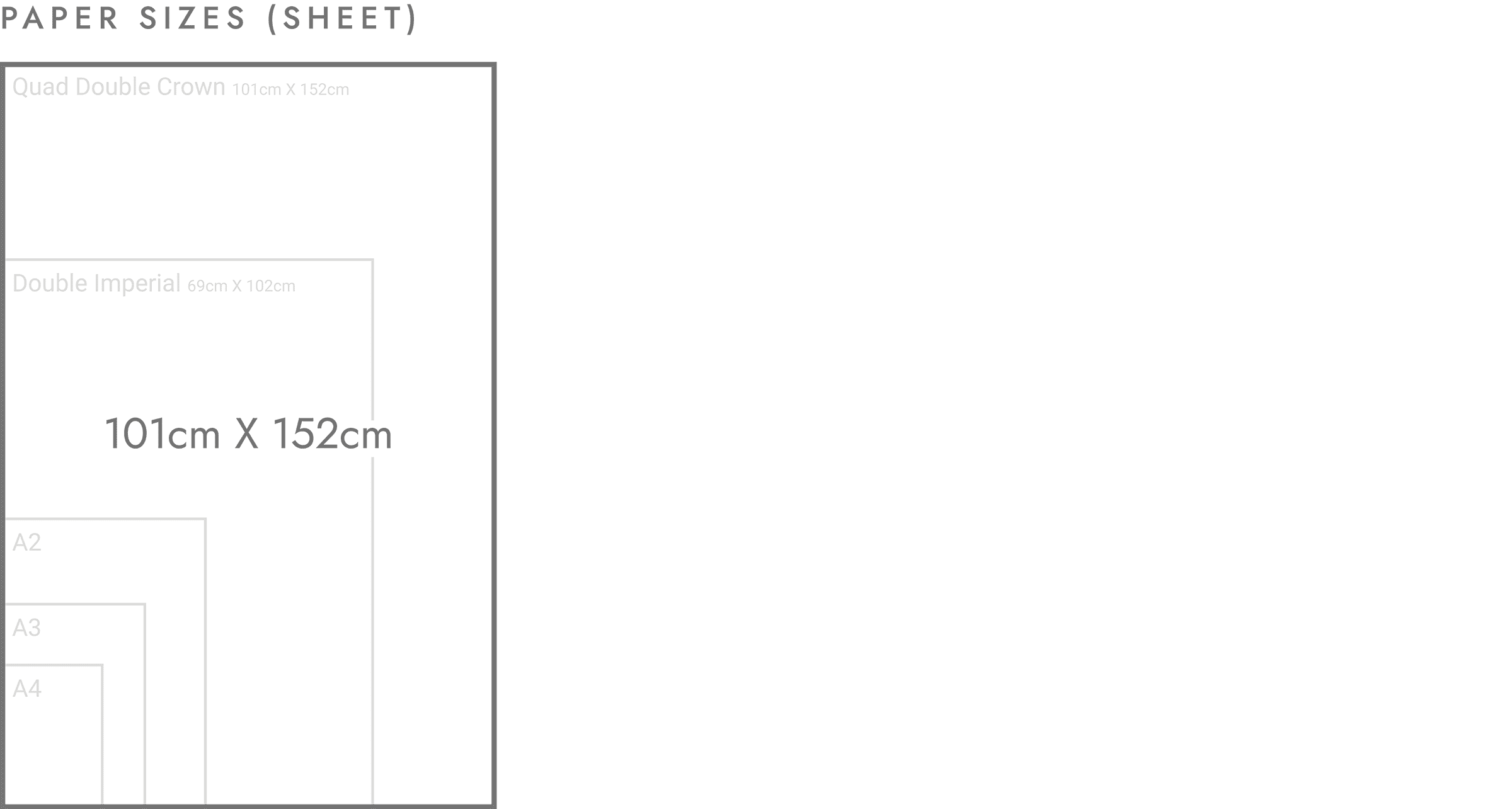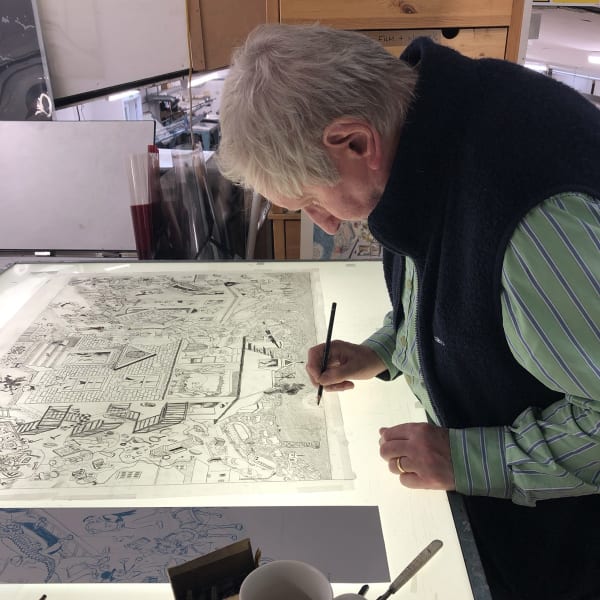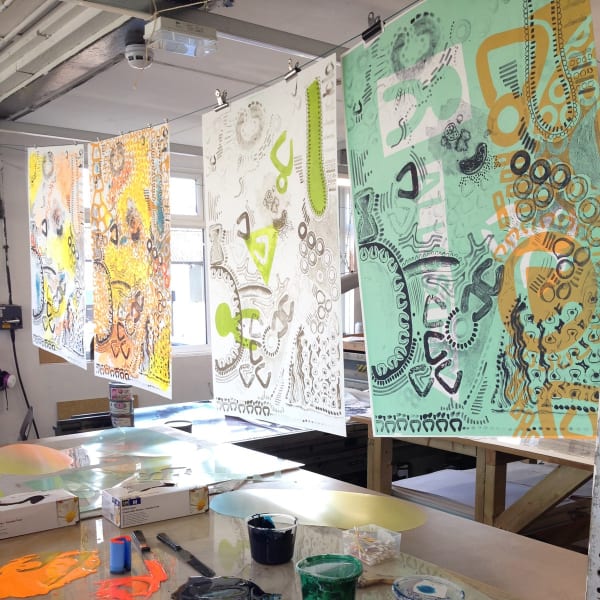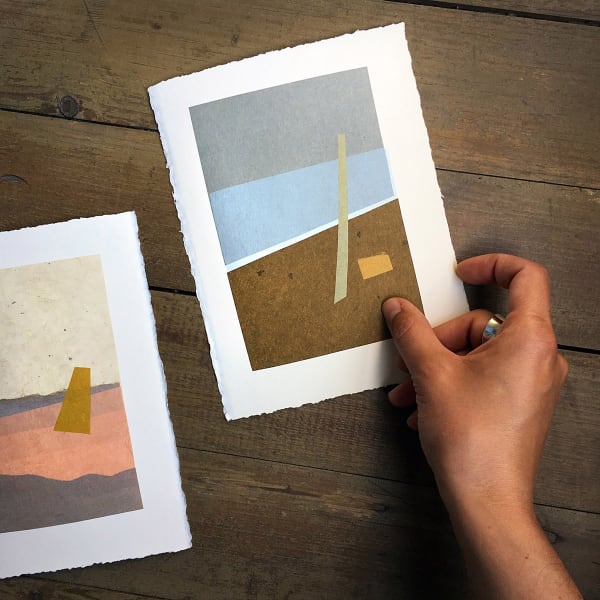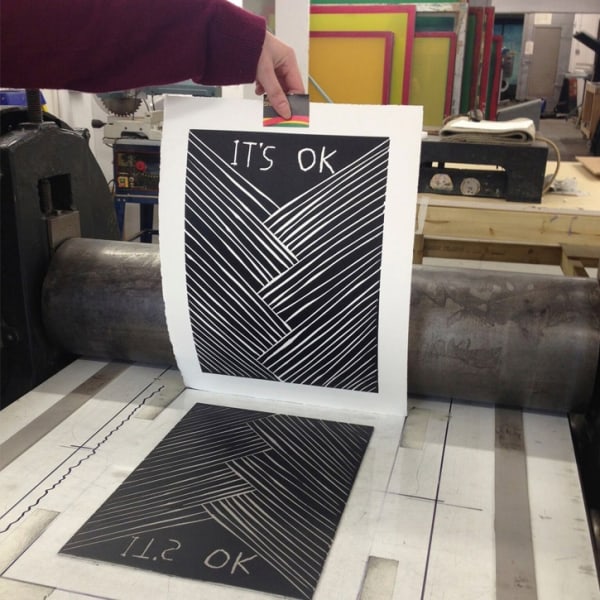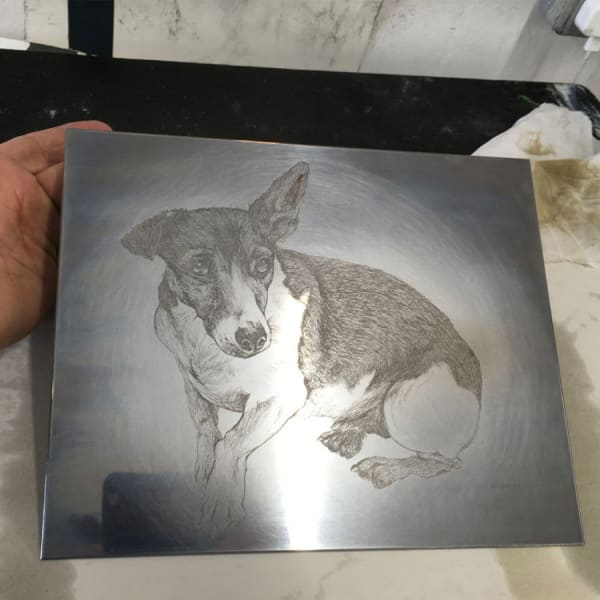-

-
-

Diamond Dust
Diamond dust is a special effect we use in the studio, adding a shimmering, textured finish to prints for a striking visual impact.
-

Leafing
Leafing, available in gold, silver, chrome, and more, adds a striking metallic finish to elevate any print with a touch of luxury.
-

Varnishes
Full and selective application of varnishes on prints. In addition, we can build up multiple layers of varnish to add height and texture to specific areas.
-

Glitter
Glitter adds a vibrant, shimmering effect to your prints, available in a variety of colors to make your artwork truly sparkle.
-

Emboss & Deboss
Emboss & Deboss effects bring a refined tactile dimension to prints, creating raised or recessed details that add depth and sophistication to any design.
-

Flocking
Flocking adds a soft, velvety texture to prints, offering a luxurious and unique finish that elevates the tactile experience of your artwork.
-

Cyanotype
Cyanotype creates a stunning, deep blue monochromatic effect, perfect for adding a timeless and artistic touch to your prints.
-

Deckled Edge
Deckled edges provide a handcrafted, organic touch to prints, highlighting the artisanal quality and bespoke nature of your artwork.
-

Collage
Collage combines various materials and textures, offering a dynamic and layered finish that brings depth and uniqueness to your prints.
-
-
SCREENPRINT PAPERS
-

SATIN PAPERS
Fine art satin paper offers a smooth, slightly textured surface with a soft sheen, combining the elegance of matte finishes with a subtle touch of gloss. It enhances colour vibrancy while maintaining deep blacks and fine detail, making it ideal for high-quality art prints and photography. The satin finish minimises glare and fingerprints, providing a refined, professional appearance suitable for framing and display.
-

VELVET PAPERS
Velvet paper has a luxurious, soft texture with a rich, matte finish that gives artwork and photographs a sophisticated, tactile feel. Its textured surface enhances depth and detail, offering a slightly muted and painterly effect, making it perfect for fine art reproductions and high-end prints. The non-reflective quality ensures minimal glare, ideal for displaying in various lighting conditions, while its absorbent nature provides excellent color retention and subtle tonal variations.
-

Textured Papers
Textured paper has a distinctive surface that adds a tactile dimension to prints, enhancing the visual depth and character of artwork and photographs. Its rich, organic feel creates an authentic, hand-crafted look, making it ideal for fine art reproductions and illustrations. The textured finish diffuses light, reducing glare and giving images a soft, natural appearance, while its high absorbency ensures vibrant colours and intricate details are preserved.
-

SPECIALIST SUBSTRATES
Special substrates like canvas, fabrics, and holographic, gold, or silver mirror finishes offer diverse, eye-catching effects. Canvas provides a textured, traditional look, while fabrics add a soft, tactile quality. Holographic substrates create prismatic colour shifts, and gold or silver mirror options give a sleek, metallic sheen. Ideal for distinctive, high-impact visuals and multi-dimensional pieces.
-
-
INKJET PAPERS
All Appropriate Paper Stocks Can Be Purchased For Individual Projects-

SOMERSET | SATIN
The smooth satin matt surface has a timeless quality which accentuates all the detail in the final print without any distractions. The 100% cotton paper contains no optical brighteners, and the natural white base adds colour, depth, and vitality to the final print. The proprietary inkjet coating guarantees superb image quality and longevity, which is essential for both limited and open edition digital fine art prints.
-

SOMERSET | TEXTURED
Created to give artists and photographers an authentic fine art inkjet paper, capable of producing impressive images. This is a stunning matte paper, with an invisible inkjet coating, whose texture will lift images, giving them a beautifully elegant fine art feel.
-

HAHNEMÜHLE | PHOTORAG
The super matt finish of Hahnemüle Photorag makes this paper one of our most popular papers amongst artists, illustrators & photographers alike. The paper gives muted blacks with even colour reproduction, and excellent detail. The surface has minimal texture with a chalky smooth cotton feel which creates smooth colour gradients.
-

HAHNEMÜHLE | PHOTORAG SATIN
Hahnemühle Photo Rag® Satin is an exceptional highlight to the Photo Rag® range and lends FineArt prints a highly individual character. The white cotton paper features the classic Photo Rag® surface with a delicate felt structure and a beautifully soft feel. In combination with the satin-gloss premium inkjet coating, it produces outstanding prints with a beautiful sense of depth and three-dimensional quality.
-

HAHNEMÜHLE | GERMAN ETCHING
This heavyweight paper has a slightly warm base tone and a strong mottled texture. It creates a print with strong colours and deep blacks that feel rich and high in contrast. This is due to the texture of the paper enabling it to hold more ink and capture the light. The German Etching is one of our heavier weight Giclée art printing papers. With its weight and strong texture this paper gives an artwork a handmade crafted feel.
-

HAHNEMÜHLE | BARYTA
Hahnemühle FineArt Baryta is a warm and bright white with a glossy surface for impressive color reproduction and strong contrasts. It is ideal for both color and black-and-white shots. The barium sulfate in the coating makes this paper reminiscent of the baryta paper used in classic analog photography.
-
-

-
Screenprint Print Size
-
Inkjet Print Size
-
THE HISTORY OF CURWEN STUDIO
Many galleries and publishers also choose the Curwen Studio to produce editions for their artists and clients including Washington Green, De Montfort Fine Art Publishing, Thames & Hudson, Marlborough Fine Art, Richard Nathanson, Belgravia Gallery, Browse and Darby, J Hewett & Sons, Ashgate Publishing, Curwen Gallery, ETOA, Oriel Yns Mon, The Geffrey Museum, Aldeborough Productions, Eyestorm, Northcote Gallery, Laz Inc., Shell Art Collection, TAG Fine Arts, Blenheim Palace, Tate Britain and Tate Enterprises, Bedford Gallery and Cecil Higgins Museum, Liberty and many others.
The Curwen Studio also enjoys a close link with Tate Britain; donating an archive of prints in 1975 for the exhibition Artists at Curwen and in 2008 celebrated the 50th Anniversary of the Studio with a further display at Tate Britain. Tate Publishing commissioned the publication ‘Art & Print: The Curwen Story’, by Alan Powers. Special Limited Editions by Paula Rego, Mark Hearld, Antony Micallef and Mary Dalton were also sold via Tate outlets along with a further Curwen edition by Mark Hearld commissioned by Tate.
-
-

Stone and Zinc Plate (autographic)
Marks can be drawn directly onto the surface using grease-based substances, from lithographic crayon, to tusche washes. If the drawing needs to be done on location and the thought of carrying a stone or plate around is unappealing, then there is the option.
-

Polymer coated photo plate (autographic)
There are a number of ways of approaching this process, but for ease of description, the artist draws directly onto a film or paper that has a degree of translucency and all the information is transferred to the plate by exposure under UV light.
-

Reproduction use of polymer coated photo plate
This process is used for making a print from an existing image. First a transparency, scan or high resolution digital file is needed, from which a set of films are made in order to transfer the information to plate.
-

Photographic Contone
A process developed for photography that allows us to print a continuous tone photographic image, which means that the quality of the image is not lost by being broken up by dot screens.
-
-
-

Etching | Hard & Soft Ground
Marks are made by drawing through a wax resist on a plate, then etched with acid. In hard ground etching, artists scratch through a smoked hard wax layer to reveal marks. Soft ground etching involves drawing on paper over the plate, where pencil pressure removes soft wax, allowing acid to etch the design. The plate is then inked and printed using a press.
-

Photo Etching
Photo etching, or photoengraving, combines photography with etching by transferring a photographic image onto a metal plate coated with light-sensitive emulsion. When exposed to light, the emulsion hardens, creating a resist, while acid etches the unprotected areas, embedding the image with depth. This technique produces fine, nuanced prints that blend photographic detail with the tactile quality of traditional etching.
-

Photo Gravure
-

DRYPOINT
Drypoint is an intaglio technique where an artist scratches lines into a metal or acrylic plate using a sharp tool, without acid. The grooves and burrs created hold ink, giving drypoint prints their characteristic soft, velvety lines with rich, slightly blurred edges. This technique is prized for its expressive, textured lines, perfect for creating intimate, moody images with a handcrafted touch. -

AQUATINT
Aquatint is an intaglio technique for creating watercolor-like tonal effects. A metal plate is coated with powdered resin and heated to adhere, then submerged in acid, which etches around the resin particles. This texture holds ink, producing tonal variations. By adjusting acid exposure or using stop-out varnishes, artists achieve gradations from light gray to deep black, making aquatint ideal for soft shading and adding depth to prints.
-

SUGARLIFT
Sugarlift etching is a technique that allows for expressive, painterly lines and textures. A sugar solution is painted onto a metal plate, and once dry, an aquatint ground is applied. The plate is then soaked, dissolving the sugar to reveal the image. When exposed to acid, the lifted areas are etched, creating rich, textured marks that bring a hand-drawn quality to the final print. -

A LA POUPEE
À la poupée is a printmaking technique for applying multiple colors to an intaglio plate in one press pass. Named after the small cloth "dolls" used to dab ink, this method enables artists to color different areas of the plate directly, avoiding separate plates for each color. By blending inks on the plate, à la poupée creates vibrant, painterly effects with a unique, hand-colored quality in each print.
-

BLIND EMBOSSING
Blind embossing is a technique that creates a raised, ink-free design on paper. An artist presses a prepared plate or stencil into damp paper, producing a subtle relief that’s visible through light and shadow. Known for its understated elegance, blind embossing adds texture and depth to prints, book covers, and stationery, enhancing their tactile and minimalist appeal. -

CARBORUNDUM
-

CHINE COLLE
Chine-collé is a printmaking technique that combines collage with traditional printing to add color, texture, or detail. A thin, delicate paper, often rice or Japanese paper, is placed on an inked plate and adhered to heavier paper during printing. This process creates layered effects and intricate details, adding depth and dimension to the final artwork. -

RELIEF PRINTS
Relief printing is a technique where an artist carves into a block, like wood or linoleum, leaving raised surfaces to hold ink. The inked block is then pressed onto paper, creating bold lines and strong contrasts. Known for its graphic quality, relief printing is used in both art and commercial applications, including woodcut, linocut, and letterpress methods.
-

HYBRID PRINTING
Hybrid printing combines multiple printmaking techniques, like relief, intaglio, lithography, and digital, in a single artwork. This approach enables artists to achieve unique textures, colors, and effects by layering or blending methods, creating rich compositions that extend beyond traditional printmaking. Hybrid printing is valued for its flexibility and creative potential.
-

SPITBITE
Spit bite aquatint is an aquatint technique where the artist applies thickened acid directly to the plate with a brush, instead of submerging it. After applying an aquatint ground, the acid, traditionally mixed with spit, is painted onto the plate. This approach allows for controlled tones and creates a watercolor-like effect in the final print.
-

WOODCUT
Woodcut is an ancient printmaking technique where an artist carves an image into a wood block, leaving uncarved areas to hold ink. When pressed onto paper, these inked surfaces produce bold, graphic prints with strong contrasts. Woodcut has long been used for both fine art and book illustration.
-

LINOCUT
Linocut is a relief printmaking technique like woodcut, but it uses a linoleum block, which is softer and easier to carve. The artist cuts away areas that will remain white, leaving raised surfaces to be inked. This technique allows for finer details and clean lines, making it ideal for bold, high-contrast images and expressive designs.
-

STEEL-FACING
Steel-facing is an intaglio technique that strengthens a copper plate by electroplating it with a thin steel layer, enhancing durability for repeated printing. This preserves fine details and textures, ensuring high-quality, consistent prints across an edition. After printing, the steel layer can be removed, returning to the original copper plate.
-

MEZZOTINT
Mezzotint is an intaglio technique that produces deep blacks and smooth tonal gradients. The artist roughens the plate’s surface with a rocker for solid blacks, then smooths areas with burnishers and scrapers for lighter tones. This creates a tonal range from dark blacks to bright highlights, valued for its dramatic contrasts, soft shadows, and painterly details.
-

MULTI-PLATE
Multi-plate printing uses several plates, each with a different color, to create a layered image. Each plate represents part of the design, like outlines or shading, and is printed in sequence on the same paper. Precise alignment ensures colors blend cohesively, making this technique ideal for vibrant, multi-colored compositions with depth.
-
